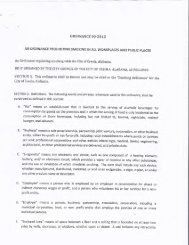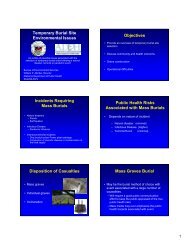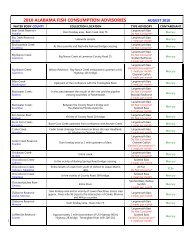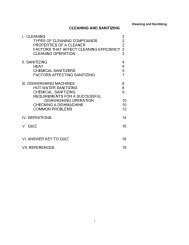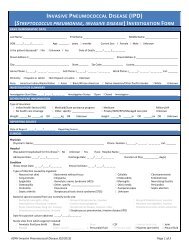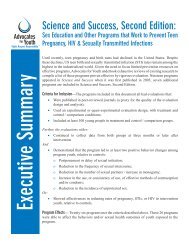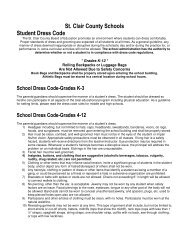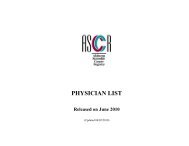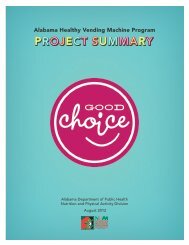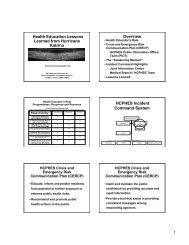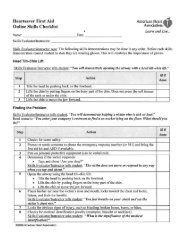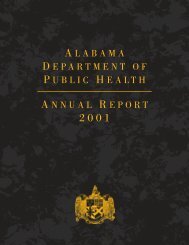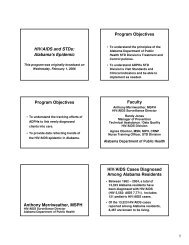2007 - Alabama Department of Public Health
2007 - Alabama Department of Public Health
2007 - Alabama Department of Public Health
Create successful ePaper yourself
Turn your PDF publications into a flip-book with our unique Google optimized e-Paper software.
center for emergency preparedness<br />
water food can opener<br />
medications<br />
first aid<br />
flashlight<br />
radio<br />
clothes<br />
personal care items Important Documents<br />
The Center for Emergency Preparedness worked with the Communications and <strong>Health</strong> Marketing Division to create a Get 10 campaign to help people learn about ten important<br />
items to have in an emergency.<br />
• 2 Strategic National Stockpile distribution<br />
exercises;<br />
• Advanced HAZMAT training with 61 in attendance;<br />
35 <strong>of</strong> the attendees became instructors;<br />
• 4 Volunteer symposiums;<br />
• Collaborated with the <strong>Department</strong> <strong>of</strong> Human<br />
Resources to host the Safe and Sound II Pediatric<br />
Conference; and<br />
• The <strong>Alabama</strong> Incident Management System<br />
(AIMS) s<strong>of</strong>tware was expanded to allow enhanced<br />
communication between health care organizations<br />
requesting assistance with patient transfers and<br />
sharing staff and equipment. The department, the<br />
<strong>Alabama</strong> Hospital Association, and the <strong>Alabama</strong><br />
Nursing Home Association partner to staff a<br />
medical transfer center during mass casualty<br />
disasters. In addition to hospitals, AIMS includes<br />
nursing homes, medical needs shelters, community<br />
health centers, and ambulances.<br />
• Hosted the third Agricultural Security Conference<br />
with 277 in attendance.<br />
The <strong>Health</strong> Resources and Services Administration’s<br />
Hospital Bioterrorism Preparedness Program provided<br />
$7,154,927 in a cooperative agreement with the<br />
department. These funds were designated to enhance<br />
hospital capacity and preparedness to respond to large<br />
numbers <strong>of</strong> patients presenting to hospitals following a<br />
naturally occurring disaster or terrorist action resulting<br />
in mass casualties.<br />
Specific activities that concentrated on the assessment<br />
<strong>of</strong> health care partners to determine the overall state <strong>of</strong><br />
readiness included:<br />
• An annual hospital mass casualty assessment to<br />
gauge the improved state <strong>of</strong> readiness <strong>of</strong> hospitals<br />
to respond to local and regional emergencies.<br />
Information gained was used to determine funding<br />
for the purchase <strong>of</strong> seven mobile medical stations.<br />
• Portable high-efficiency particulate air filtration<br />
units were purchased to increase the negative<br />
pressure isolation capacity <strong>of</strong> hospitals across the<br />
state. These units will allow the health centers to<br />
set up a negative pressure isolation environment to<br />
<strong>of</strong>fload patient care from local hospitals.<br />
• Conversion kits were purchased to allow up to 100<br />
buses to be converted to transport patients during<br />
an emergency evacuation.<br />
Additional activities included:<br />
• Monthly reporting and quarterly tracing and<br />
reporting <strong>of</strong> emergency preparedness team activities<br />
for CDC and HRSA grant projects<br />
• Enhancement <strong>of</strong> a call center database to be used<br />
in emergency events to help better track resource<br />
requests from affected public areas<br />
• Addition <strong>of</strong> radiation response teams in each public<br />
health area<br />
14



